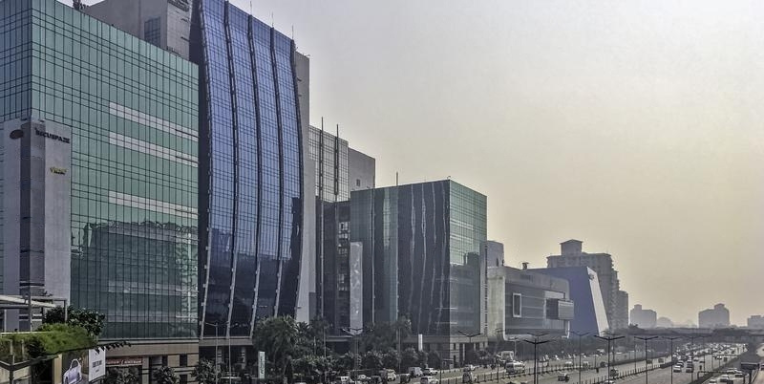Find the programme that meets your requirements and aspirations.
Apply nowStudent Blogs
- SPJIMR
- Blog
- DLF: India’s attempt at green real-estate
DLF: India’s attempt at green real-estate

DLF Limited symbolises the force of a desire, goal, and enthusiasm for developing environments that promote healthy living, and well-being. It is a real estate firm that has been a trailblazer in several residential and commercial projects, capitalising on its industry expertise, its vast resources, and the ability to forecast its customer’s needs. Today, the brand is the industry leader because of its unrivalled quality, innovation, and governance. This has produced continuous growth and high levels of customer satisfaction, something that has defined this company over 75 years of its existence.
Today, we take a look at DLF, not for its established presence, but for its efforts towards bringing sustainability to the real estate industry.
DLF understood the impact its projects have on the environment, and set out to make its flagship real estate facility, DLF Cybercity, a more environmentally-friendly and green office–residential complex, perfect for its customers. But, developing this project meant revamping a private city which spans more than 125 acres, and one that is home to several fortune 500 and leading domestic business houses. The visionary founder, Dr. Khushal Pal Singh (referred to as KP by his employees), identified this challenge and set out to ‘Greenify’ this massive brownfield project. Furthering this vision, KP set out to create and operate an integrated model of sustainability, incorporating a plethora of green initiatives.
DLF’s sustainability model had three main pillars: Water management, e-waste management, and green electricity generation. We start by discussing their efforts towards water management.
DLF installed rainwater harvesting centres, water treatment centres, and created India’s most advanced black-water filtration system. in order to reduce the use of freshwater for the purpose of landscape maintenance. Working in tandem with the residents from DLF’s numerous housing societies, they even installed state-of-the-art water management IoT hardware to check for leakages in taps and faucets at a floor/house level.
But DLF’s sustainability efforts are not limited to just that. Over the last two decades, under operation of DLF, Gurugram has witnessed unprecedented real estate activity, transforming the once sleepy semi-rural town into one of India’s largest IT/ITES outsourcing hubs. Almost all major IT companies have leased office space with DLF, and as a result, the office complexes generate a lot of e-waste in the form of broken and rundown hardware used by said IT/ITES firms. To encourage proper disposal of the waste, DLF ensures that all its trash is segregated at the collection point, and is processed separately. Moreover, the conglomerate has also installed e-waste dustbins in all its commercial spaces. After segregating this e-waste from regular waste, DLF dismantles all the procured e-waste to remove the components that may adversely affect the environment (like lithium batteries present in older laptops), and processes them separately. In fact, the business house also tries to reuse plastics and other nonbiodegradables, instead of disposing them in landfills.
These pillars of DLF’s sustainability model were further bolstered with green initiatives like availability of Electric Vehicles for public transport, and an excellent privately-built last-mile rapid metro that reduced the number of cars on the road, resulting in reduction of per capita carbon emission in the complex.
Being such a large consumer of electricity, DLF realised the impact of this massive use on their operating expenses. To reduce this usage, they decided to switch to solar energy as their primary form of energy generation for their commercial assets. The firm also encouraged Housing societies of their residential blocks to make the switch.
If these efforts already seem significant, DLF has more to offer. The firm has adopted a new design policy for its new infrastructure called ‘green design’. Under this design philosophy, all new projects are encouraged to keep their operating and ancillary support facilities (like cooling systems, lifts, etc.) to bare minimum, and to opt for more eco-friendly alternatives. An example of this change is the adoption of wide-based and longer steps with a much gentler incline to reduce the load individuals feel while using them. Another example of this philosophy is the use of green leafy vines instead of reflective aluminium or tinted glass on the outside of its buildings, in order to reflect the sunlight and help keep the buildings cooler. While these changes may seem simple and relatively easy to implement, they go a long way in helping the firm save millions on its P&L statement.
The efforts of DLF have not gone unrecognised, and it has been awarded the prestigious US Green Building Council’s certification of ‘LEED Platinum for Cities & Communities’, as verified by Green Business Certification Inc.
The recognition received by DLF is testimony to their sustainable efforts. But, with many organizations being accused of “greenwashing”, it is necessary for DLF to ensure that the efforts are not tokenistic. It is also incumbent upon other stakeholders like investors and consumers to push organizations to further their efforts towards sustainability that is ‘transformational’.
Even though achieving sustainability is a long-term endeavour, every little effort by stakeholders can have a monumental impact. It is time for the world to reckon that there’s a long way to go before we achieve a future that is truly sustainable.
Recent Posts
- #DoCCDiaries: Community springs in the Bag Guler Panchayat July 9, 2024
- Experiential learning: My month-long advocacy internship with PGDM’s DoCC June 25, 2024
- My journey: Transforming lives through Abhyudaya June 6, 2024
- Discovering cutting-edge applications of AI and ML in the finance sector June 4, 2024
- #DoCCDiaries: Durbar: Fight against stigma for ‘dignity of profession’ May 28, 2024

